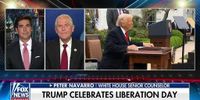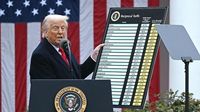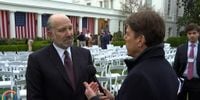On April 2, 2025, President Donald Trump made a significant announcement that has sent ripples through global markets and trade relationships. Dubbed "Liberation Day," the president unveiled a far-reaching tariff policy that includes a 10% baseline tariff on nearly all imports into the United States, alongside much steeper rates on selected countries. The implications of these tariffs are profound, affecting not only international trade but also domestic manufacturing and consumer prices.
The new tariff regime imposes hefty rates on various nations, with China facing a staggering 34% tariff, the European Union at 20%, Vietnam at 46%, and Taiwan at 32%. This decision has already led to a noticeable drop in market performance, with European stocks closing 2.7% lower the following day, according to CNBC.
Trump's administration is predicting that these tariffs could generate around $600 billion annually, potentially amounting to $6 trillion over the next decade. White House trade adviser Peter Navarro has emphasized that these tariffs will serve as a substantial tax on foreign nations and companies, suggesting that entities wishing to avoid these tariffs could bring their jobs to the U.S. instead.
However, the announcement has raised eyebrows among economists and trade experts, who are questioning the methodology behind the tariff calculations. Critics point out that the rates seem to be based on a formula that divides the trade deficit the U.S. has with a country by the value of goods that country exports to the U.S. Julian Klymochko, CEO and CIO of Investment firm Accelerate FT, labeled the tariff strategy as potentially the "biggest economic blunder of all time." He argued that the calculations used to determine these tariffs are incoherent and could lead to unintended consequences.
For instance, the trade deficit with China stands at $295.4 billion, while U.S. imports from China are valued at $438.9 billion. The resulting tariff rates, as noted by Klymochko, do not reflect traditional tariff structures but rather a convoluted interpretation of trade balance. Ryan Petersen, CEO of Flexport, corroborated this perspective by sharing a chart that plotted the predicted tariff rates against actual figures, further illustrating the discrepancies in Trump's tariff formula.
Moreover, the impact of these tariffs extends to the automotive industry, where a 25% tariff on all foreign-built autos and auto parts is also being implemented. This move aims to incentivize automakers to bring production back to American soil, thereby restoring jobs and manufacturing capabilities that have been lost to offshoring. As it stands, about half of the 16 million passenger vehicles sold in the U.S. annually are imports, primarily from countries like Germany, Japan, Mexico, and South Korea.
Critics of the tariffs, including Senate Minority Leader Chuck Schumer, have expressed concern that the administration's approach lacks precision. Schumer noted that while tariffs may be necessary in certain areas, the current strategy seems to be a blunt instrument rather than a targeted approach. He remarked, "They use a blunderbuss instead of a scalpel, they use a hatchet instead of a scalpel, they use a chainsaw instead of a scalpel." This sentiment reflects a broader unease about the potential for increased consumer prices as automakers may raise costs to maintain profitability.
In light of these developments, the automotive sector is bracing for a wave of changes. Stellantis, the parent company of Chrysler, has already paused production at its plants in Canada and Mexico in response to the new tariffs. With many auto parts sourced from these countries, the tariffs could lead to increased costs for American consumers as car manufacturers adjust their pricing strategies.
While the Trump administration maintains that these tariffs will revitalize American manufacturing and create jobs, the reality remains complex. The intricacies of international trade mean that retaliation from affected countries is likely, and the potential for a trade war looms large. As countries react to the new tariffs, the global economic landscape could shift dramatically.
In conclusion, President Trump's sweeping tariff policy represents a bold and controversial move in U.S. trade strategy. As markets react and analysts dissect the implications, the long-term effects on both American consumers and international relations will become clearer. Whether this policy will indeed lead to the promised economic revival or result in unintended consequences remains to be seen.







